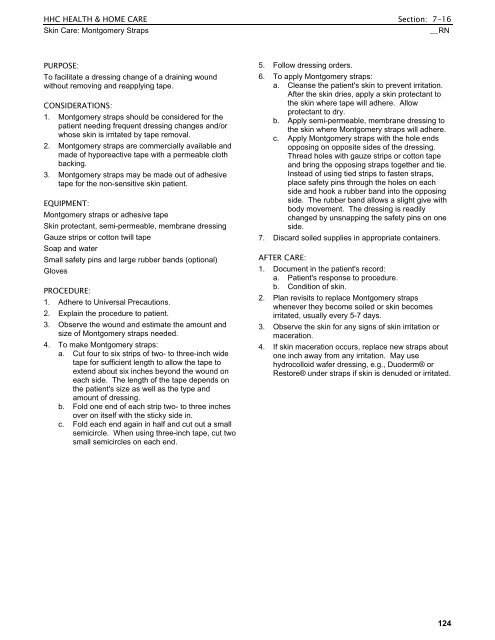HHC Health & Home Care Clinical Policy And
HHC Health & Home Care Clinical Policy And
HHC Health & Home Care Clinical Policy And
Create successful ePaper yourself
Turn your PDF publications into a flip-book with our unique Google optimized e-Paper software.
<strong>HHC</strong> HEALTH & HOME CARE Section: 7-16<br />
Skin <strong>Care</strong>: Montgomery Straps __RN<br />
PURPOSE:<br />
To facilitate a dressing change of a draining wound<br />
without removing and reapplying tape.<br />
CONSIDERATIONS:<br />
1. Montgomery straps should be considered for the<br />
patient needing frequent dressing changes and/or<br />
whose skin is irritated by tape removal.<br />
2. Montgomery straps are commercially available and<br />
made of hyporeactive tape with a permeable cloth<br />
backing.<br />
3. Montgomery straps may be made out of adhesive<br />
tape for the non-sensitive skin patient.<br />
EQUIPMENT:<br />
Montgomery straps or adhesive tape<br />
Skin protectant, semi-permeable, membrane dressing<br />
Gauze strips or cotton twill tape<br />
Soap and water<br />
Small safety pins and large rubber bands (optional)<br />
Gloves<br />
PROCEDURE:<br />
1. Adhere to Universal Precautions.<br />
2. Explain the procedure to patient.<br />
3. Observe the wound and estimate the amount and<br />
size of Montgomery straps needed.<br />
4. To make Montgomery straps:<br />
a. Cut four to six strips of two- to three-inch wide<br />
tape for sufficient length to allow the tape to<br />
extend about six inches beyond the wound on<br />
each side. The length of the tape depends on<br />
the patient's size as well as the type and<br />
amount of dressing.<br />
b. Fold one end of each strip two- to three inches<br />
over on itself with the sticky side in.<br />
c. Fold each end again in half and cut out a small<br />
semicircle. When using three-inch tape, cut two<br />
small semicircles on each end.<br />
5. Follow dressing orders.<br />
6. To apply Montgomery straps:<br />
a. Cleanse the patient's skin to prevent irritation.<br />
After the skin dries, apply a skin protectant to<br />
the skin where tape will adhere. Allow<br />
protectant to dry.<br />
b. Apply semi-permeable, membrane dressing to<br />
the skin where Montgomery straps will adhere.<br />
c. Apply Montgomery straps with the hole ends<br />
opposing on opposite sides of the dressing.<br />
Thread holes with gauze strips or cotton tape<br />
and bring the opposing straps together and tie.<br />
Instead of using tied strips to fasten straps,<br />
place safety pins through the holes on each<br />
side and hook a rubber band into the opposing<br />
side. The rubber band allows a slight give with<br />
body movement. The dressing is readily<br />
changed by unsnapping the safety pins on one<br />
side.<br />
7. Discard soiled supplies in appropriate containers.<br />
AFTER CARE:<br />
1. Document in the patient's record:<br />
a. Patient's response to procedure.<br />
b. Condition of skin.<br />
2. Plan revisits to replace Montgomery straps<br />
whenever they become soiled or skin becomes<br />
irritated, usually every 5-7 days.<br />
3. Observe the skin for any signs of skin irritation or<br />
maceration.<br />
4. If skin maceration occurs, replace new straps about<br />
one inch away from any irritation. May use<br />
hydrocolloid wafer dressing, e.g., Duoderm® or<br />
Restore® under straps if skin is denuded or irritated.<br />
124







